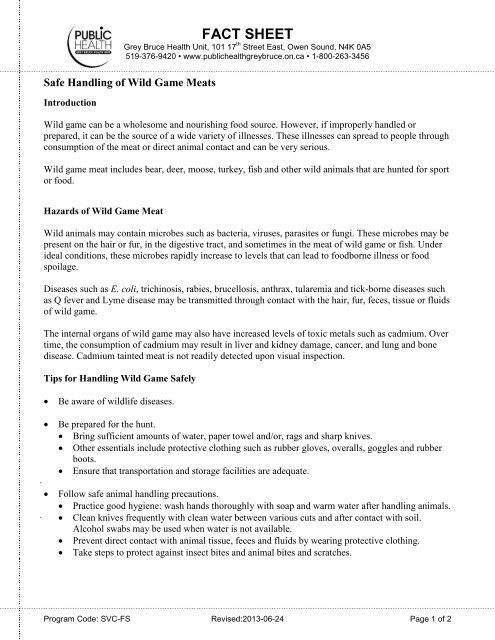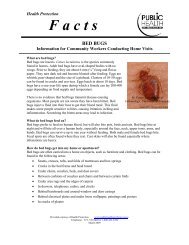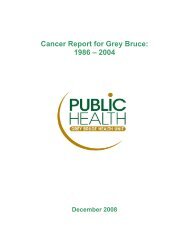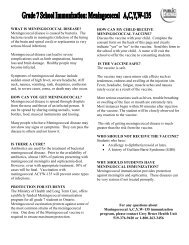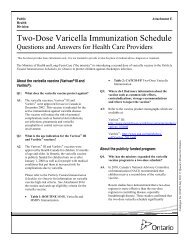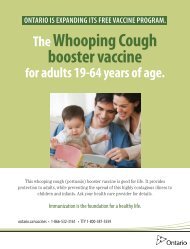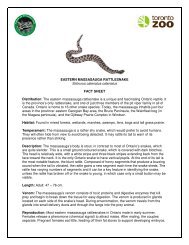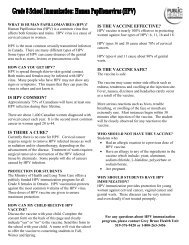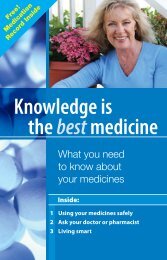Wild Game Meats - Grey Bruce Health Unit
Wild Game Meats - Grey Bruce Health Unit
Wild Game Meats - Grey Bruce Health Unit
You also want an ePaper? Increase the reach of your titles
YUMPU automatically turns print PDFs into web optimized ePapers that Google loves.
FACT SHEET<br />
<strong>Grey</strong> <strong>Bruce</strong> <strong>Health</strong> <strong>Unit</strong>, 101 17 th Street East, Owen Sound, N4K 0A5<br />
519-376-9420 • www.publichealthgreybruce.on.ca • 1-800-263-3456<br />
Safe Handling of <strong>Wild</strong> <strong>Game</strong> <strong>Meats</strong><br />
Introduction<br />
<strong>Wild</strong> game can be a wholesome and nourishing food source. However, if improperly handled or<br />
prepared, it can be the source of a wide variety of illnesses. These illnesses can spread to people through<br />
consumption of the meat or direct animal contact and can be very serious.<br />
<strong>Wild</strong> game meat includes bear, deer, moose, turkey, fish and other wild animals that are hunted for sport<br />
or food.<br />
Hazards of <strong>Wild</strong> <strong>Game</strong> Meat<br />
<strong>Wild</strong> animals may contain microbes such as bacteria, viruses, parasites or fungi. These microbes may be<br />
present on the hair or fur, in the digestive tract, and sometimes in the meat of wild game or fish. Under<br />
ideal conditions, these microbes rapidly increase to levels that can lead to foodborne illness or food<br />
spoilage.<br />
Diseases such as E. coli, trichinosis, rabies, brucellosis, anthrax, tularemia and tick-borne diseases such<br />
as Q fever and Lyme disease may be transmitted through contact with the hair, fur, feces, tissue or fluids<br />
of wild game.<br />
The internal organs of wild game may also have increased levels of toxic metals such as cadmium. Over<br />
time, the consumption of cadmium may result in liver and kidney damage, cancer, and lung and bone<br />
disease. Cadmium tainted meat is not readily detected upon visual inspection.<br />
Tips for Handling <strong>Wild</strong> <strong>Game</strong> Safely<br />
<br />
<br />
<br />
Be aware of wildlife diseases.<br />
Be prepared for the hunt.<br />
Bring sufficient amounts of water, paper towel and/or, rags and sharp knives.<br />
Other essentials include protective clothing such as rubber gloves, overalls, goggles and rubber<br />
boots.<br />
Ensure that transportation and storage facilities are adequate.<br />
Follow safe animal handling precautions.<br />
Practice good hygiene: wash hands thoroughly with soap and warm water after handling animals.<br />
Clean knives frequently with clean water between various cuts and after contact with soil.<br />
Alcohol swabs may be used when water is not available.<br />
Prevent direct contact with animal tissue, feces and fluids by wearing protective clothing.<br />
Take steps to protect against insect bites and animal bites and scratches.<br />
Program Code: SVC-FS Revised:2013-06-24 Page 1 of 2
FACT SHEET: Safe Handling of <strong>Wild</strong> <strong>Game</strong> <strong>Meats</strong><br />
519-376-9420 • www.publichealthgreybruce.on.ca • 1-800-263-3456<br />
<br />
<br />
<br />
Use proper field dressing procedures.<br />
Eviscerate or gut the animal as soon as possible.<br />
Avoid piercing the intestinal tract because harmful microbes contained in the feces may<br />
contaminate the flesh. Thoroughly wash hands and knives and remove and discard contaminated<br />
meat portions if this happens.<br />
Remove and discard the liver, kidneys and heart as soon as possible after kill as these organs<br />
may have elevated levels of the metal cadmium. Cadmium intake in excess of the recommended<br />
amount is toxic to humans.<br />
Keep the carcass clean by using clean hands and tools, by keeping the carcass off the ground and<br />
by removing loose hair and foreign matter.<br />
Protect the carcass from vermin by covering with clean cheesecloth.<br />
Keep the inside of the carcass dry since damp meat spoils faster. Wipe out excess blood and<br />
moisture with paper towels or a clean rag and clean water. Use as little water as possible.<br />
Cool the carcass quickly. Keep it chilled at 4C (40°F) or lower in the field and during<br />
transportation. Refrigerate or freeze as soon as possible.<br />
Select a reputable butcher for custom cutting or processing of the wild game meat.<br />
Cooking wild game.<br />
Practice good personal hygiene. This includes frequent handwashing before and after handling<br />
wild game meat and following any operations when hands may have become contaminated.<br />
Use only clean utensils and separate raw meats from other foods that are ready to eat.<br />
Wash and sanitize all surfaces and utensils after they have touched uncooked game meat.<br />
Ensure that game meat is cooked to a safe internal temperature of 74C/165F (82C/180F for<br />
whole poultry). This is necessary to destroy any food poisoning organisms and parasites that may<br />
be in the meat.<br />
Portion uncooked meat into meal size amounts, label with contents and date and then refrigerate<br />
or freeze immediately.<br />
Use all fresh frozen game products within 8 months and seasoned or cured frozen game meat<br />
products in 4 months.<br />
Program Code: SVC Revised:2013-06-24 Page 2 of 2


